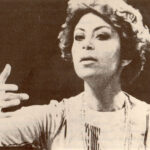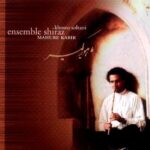
The text you are reading is about Hamed Fathi, a guitarist and one of Lilly Afshar’s students, which was previously published on the Persian website HarmonyTalk.com:
Lilly Afshar the Iranian Guitarist passed away on October 24, 2023 at age 63 due to cancer in Tutkabon, Mazandaran, Iran. Afshar, who had been living in the United States for years, had recently constructed a villa in Tonekabon and was residing there during her trips to Iran.
Afshar, moved to the United States in 1977 to study at the Boston Conservatory of Music. She earned both her bachelor’s and master’s degrees in guitar from there. In 1989, Afshar received her doctorate from Florida State University, where she wrote her thesis on 24 Caprichos de Goya by Mario Castelnuovo-Tedesco. In 1994, she became the first musician to record Castelnuovo-Tedesco’s guitar composition. She was also the first woman in the world to earn a doctorate in classical guitar.
Afshar was awarded the 2000 Orville H. Gibson Award for Best Female Classical Guitarist, as well as three annual “Premier Guitarist” awards by the Memphis Chapter of the National Academy of Recording Arts & Sciences. She was also awarded the 2008 Distinguished Teaching Award, the 2000 Eminent Faculty Award, and the 1996 Distinguished Research Award at The University of Memphis. Afshar was chosen as “Artistic Ambassador” for the United States Information Agency to Africa, and was among twelve guitarists selected to play for Andrés Segovia in his master classes held at the University of Southern California.
Afshar’s style was a unique blend of Persian and Baroque music with classical guitar. Global Rhythm magazine described it as “the delicate yet powerful sound of the classical guitar with the melodic ornamentation of Persian and Baroque music” . Washington Post critic Joan Reinthaler praised Afshar’s musical sense and restraint, noting that “Afshar has the delicate touch and the keen concentration that characterizes the best guitarists, and she also has the musical sense and restraint that characterizes only a few”.
Many albums were released by him, as well as instructional books (Classical Guitar – Two Volumes) that were published…
It is worth mentioning that he held several concerts and master classes throughout Iran.
These are all glimpses of his international activities that always catch the media’s attention in introducing him, but without a doubt, Lilly Afshar is the most influential guitarist and teacher in the history of classical guitar in Iran that has ever been seen.
Writing about Lilly Afshar is difficult for me… I had the honor of sitting as her student in class for years and organizing more than ten concerts and master classes throughout Iran.
For me, who was not over twenty years old at the time, Lilly Afshar was another definition of “practice” and melting in playing music, from the kind of musicians that no longer have their match, from a hardworking and tireless generation, and today after two decades, she is like a magnificent crown on the head of classical guitar in Iran.
It was not his international positions, awards, and status that caught the eyes and ears towards him, but with a rich and dignified repertoire of a world-class guitarist… His admirable performances that he brought to the stage in Iran still have no match in Iran. In his master classes, educational points were expressed for the first time that were rarely heard from other teachers in class, even traditional teachers whose pride was their self-taughtness!
The importance of local melodies and Iranian modal music in a very closed and stagnant space of guitar was considered a kind of “taboo-breaking” that only Lilly Afshar could handle, someone who carried high academic knowledge as well as technique and creativity… Despite all this, relying on his admirable willpower and ability, he was able to tolerate malicious criticisms for years. More than anything else, today’s sorrow remains: it’s a pity… if there was an opportunity to benefit more from her!
Iranian classical guitar should be divided into before and after Lilly Afshar, and perhaps something beyond the common clichés is worthy of her. More than two decades of teaching, holding master classes, concerts, publishing albums and instructional books cannot be reduced to a view full of clichés or a biased view or an absurdity due to the feeling of pain and sorrow.
Only the stature of a teacher like her deserves respect because no guitarist in Iran has been able to achieve her success both internationally and domestically.
An artist who alone for more than twenty years traveled to all parts of Iran without any government or private support to promote classical guitar.
Writing about legends is difficult… Writing about Lilly Afshar is even harder.
Rest in peace…









